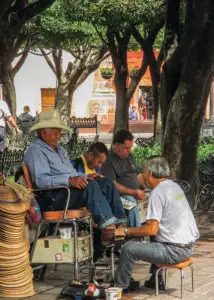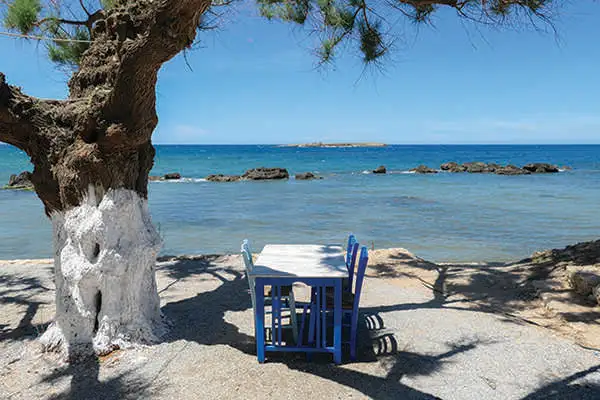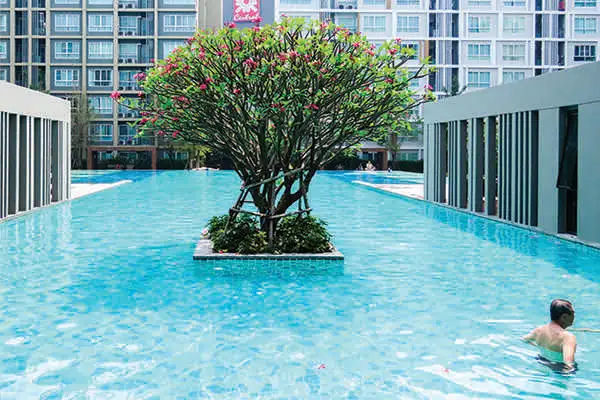By Phyl Doppelt
A rich burgundy color, it is sweet, but not too syrupy, and generates a warm glow as it makes its way down into the belly. This is Ginja, a Portuguese liqueur believed to cure anything from tonsilitis to the blues. The full name is Ginginha, but it is generally called Ginja, and the best way to sample it is at a Ginja bar in Lisbon. One such bar, Ginginha do Carmo, dates from the 1930s. It’s located at the foot of the heritage iron steps that lead from Rossio Station to Rossio Square.
An A-frame board lists the menu, which is limited to five items. There are no seats and patrons stand at little tables sipping their Ginja, chatting to whomever happens to be sharing a table.
The bar is tucked into space the size of a closet, with a counter, big enough to accommodate three people. The shelves are stocked with bottles of Ginja, which is the only alcohol served.
The liqueur originated in monasteries in the 17th century and is made from fermented sour morello cherries. Picked in June when ripe, infused with spices and lots of sugar, then soaked in aguardiente— a firewater Portuguese brandy—it is left to mellow for about five months. When the process is completed, the liqueur takes on a mellow velvety red color and has an alcohol level of about 18%.
This particular bar serves a brand called Espinheira Ginjinha, named after the monk Francisco Espinheira, who is said to have created the original recipe.
Ginja can be sipped slowly or knocked back in one gulp like schnapps. Served either with or without the cherries (in Portuguese con and sem) it is dispensed in a shot glass or in chocolate cups. I go for the chocolate cups. They are a little smaller than the shot glass, so a serving is two tots, and the chocolate and Ginja make for a flavorsome combination.
Ginja bars are part of the cash economy, so know before you pay, they do not accept credit cards. The chocolate cups cost €1.65 ($2) and the shot glass is €1.35 ($1.65) per serving.
An observation: To get the full “glow” of the Ginja, it may take more than one shot to cure whatever ails you.
Brush Up Your Dancing Shoes in San Miguel

When visiting San Miguel de Allende, Mexico, escape on a Sunday afternoon to Zandunga, where the focus is on live music and energetic dancing. It’s located in a picturesque countryside setting, nestled in the rolling hills of Jalpa. The venue is open-air, but with a protective roof for shade. Building and operating Zandunga has been a labor of love for musician Gil Gutierrez and his wife, Rebecca.
There are plenty of tables where you can relax while imbibing, eating, and listening to world-class music. Gil—an accomplished jazz and classical guitarist—performs on Sundays, mixing musicians and styles that include jazz, flamenco, Cuban, and Mexican genres.
Doors open at 1 p.m. and a Mexican buffet is served from 2 p.m. to 4 p.m.
Gil performs the first set at 3 p.m., accompanied by his band, and often has a special guest. On my last visit the guest performer was a spellbinding Russian violinist. I was delighted when they played several classic Piazzola tango pieces.
Next up are The Mavericks—a local rock ‘n’ roll band that picks up the pace. That’s when it’s time to step onto the dance floor and boogie. (During COVID 19, space has been provided to dance next to each table.) You’ll find Zandunga 12 miles from town, on the road to Jalpa. Expect a 15-20 minute ride, by taxi or car. Entry is $30, buffet included.—Ann Kuffner.
GREECE GETS NOMAD VISAS RIGHT

Jeff D. Opdyke
You have, no doubt, seen the stories over the past year regarding countries hawking digital nomad visas. In a pandemic-addled world, it’s a way to attract something more than short-term tourists.
By and large, most of those visas aren’t worth the effort. They’re often expensive and many bid you adieu after a year. That means just as you’re settling into your new life living and working abroad, you have to leave. Frankly, I’d rather just pursue a temporary residence visa somewhere that converts into a long-term residence permit after a year.
But now along comes Greece with what might be the best digital nomad visa I’ve yet seen. Details aren’t final, but here’s the idea:
Greece gives you a digital-nomad visa and you’re taxed only on 50% of your income. That rate is good for seven years, which happens to match the amount of time you must live in Greece before applying for citizenship and a Greek passport. That’s a European Union passport, which gives free rein across much of the continent.
If this plan comes to pass, it will be a great way into the EU—and a gorgeous place to live.
These are the kinds of opportunities—rarely front and center in traditional financial media—that I explain in my Global Intelligence Letter and daily Field Notes. See: IntLiving.com/FieldNotes.

Dine in Italy’s “Dying Town,” But Be Quick
Cross a bridge to another world, where fog can swirl in without warning, where the atmosphere seems stopped in time. But this town isn’t stopped, it’s slowly slipping away—and I mean physically, not metaphorically.
Civita di Bagnoregio, in upper Lazio near the Umbria border, is plopped on a bluff, and pieces of it crumble away annually into the canyon below.
Despite its ominous-sounding moniker—“the dying town”—Civita di Bagnoregio is one of the prettiest villages in Italy, and a number of aspects particular to it alone make it worth visiting.
To reach the village, you have to walk across a 200-meter- (656-foot) long footbridge that spans the Valle dei Calanchi (Valley of the Canyons). Pass under the Porta Santa Maria gate and into a set-apart world of ivy-draped buildings, sliver-like lanes decked with color-splashed flower boxes, hidden courtyards, and spectacular overlooks.
The erosion formations below the bluff will already give you a clear idea of the phenomenal forces of nature that are whittling away at Civita, particularly if you’re there when the river is in full pelt, but you can get a deeper glimpse into the destructive forces in action at the Geological Museum.
Enjoy lunch at one of the excellent trattorias, whose owners are simply heroic in their daily determination to haul ingredients across the bridge.
Just 11 folks reside in Civita year-round, most having made the move across to the bigger, more easily accessible Bagnoregio. But the hold-outs get a magical place that is suspended in the air—and in time.

Valerie Fortney-Schneider, IL Italy correspondent, resides in the southern Italian region of Basilicata. Italy@internationalliving.com
OVERLOOKED PROFIT PLAYS IN THAILAND
Ronan McMahon
When I first visited Chiang Mai in 2013, it had just arrived as a major regional hub for trade, commerce, and education. Whole areas were taken over by digital nomads, students from all over Asia, Japanese retirement communities, Chinese investors, and expats.
Back then, thanks to the influx of rental-seeking foreigners, I found opportunities to make gross rental yields in the region of 10% to 15% per year.
Today, the opportunity is somewhat thinner on the ground. But there are still some fertile pockets for wise investors.

For instance, I found a pricing anomaly in the neighborhood of Nimmanhaemin—one of Chiang Mai’s most popular districts.
The thing is, for cultural reasons, Chinese and Thai buyers mostly look for new condos. And they typically aren’t very interested in rental returns—real estate is more a store of wealth for them.
That means older, and usually larger, condos can be bought at approximately one-third the cost per square foot. These larger units are highly sought after by the growing international community, but supply doesn’t meet demand, creating strong income potential for owners.
Take one 1,399-square-foot condo I got word about from a contact on the ground. Priced at around $136,524, it could easily rent long-term for $1,200 a month. That’s a gross yield of 10.55%.

